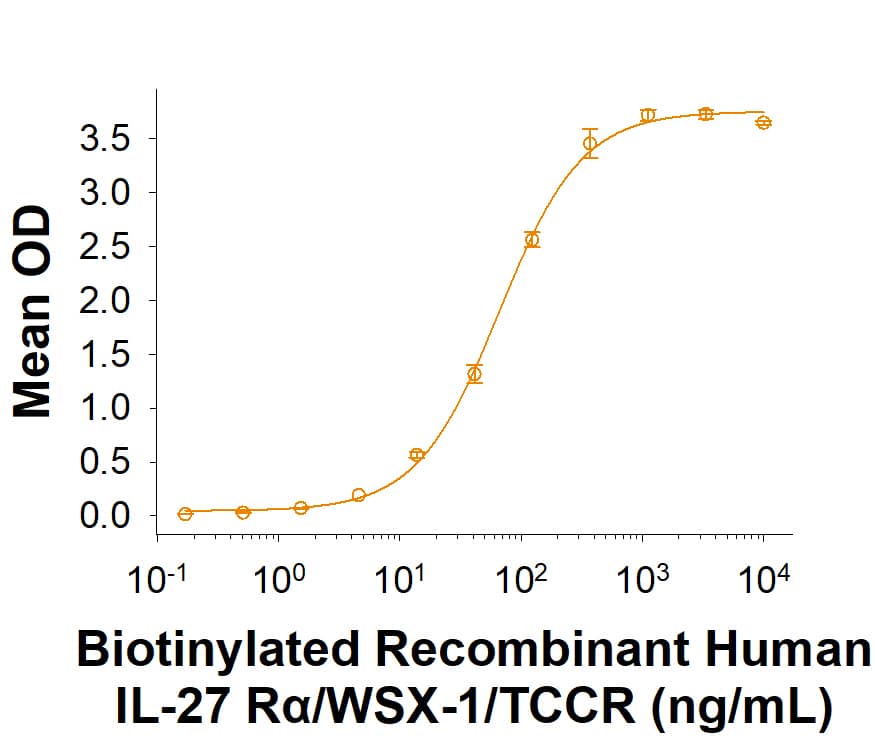Recombinant Human IL-27 Ra/WSX-1/TCCR Fc Biotin Protein, CF
R&D Systems, part of Bio-Techne | Catalog # BT1479

Key Product Details
Source
Structure / Form
Biotinylated via amines
Conjugate
Applications
Product Specifications
Source
| Human IL-27Ra (Gly34-Lys516) Accession # Q6UWB1.2 |
IEGRMD | Human IgG1 (Pro100-Lys330) |
| N-terminus | C-terminus |
Purity
Endotoxin Level
N-terminal Sequence Analysis
Predicted Molecular Mass
SDS-PAGE
Activity
Biotinylated Recombinant Human IL-27 R alpha/WSX-1/TCCR Fc Chimera (Catalog # BT1479) binds Recombinant Human IL-27 (Catalog # 2526-IL/CF) with an ED50 of 12.0-160 ng/mL.
Scientific Data Images for Recombinant Human IL-27 Ra/WSX-1/TCCR Fc Biotin Protein, CF
Biotinylated Recombinant Human IL‑27 R alpha/WSX‑1/TCCR Fc Chimera Protein Binding Activity.
Biotinylated Recombinant Human IL-27 R alpha/WSX-1/TCCR Fc Chimera Protein (Catalog # BT1479) binds Recombinant Human IL-27 (2526-IL/CF) with an ED50 of 12.0-160 ng/mL.Biotinylated Recombinant Human IL‑27 R alpha/WSX‑1/TCCR Fc Chimera Protein SDS-PAGE.
2 μg/lane of Biotinylated Recombinant Human IL‑27 R alpha/WSX‑1/TCCR Fc Chimera Protein (Catalog # BT1479) was resolved with SDS-PAGE under reducing (R) and non-reducing (NR) conditions and visualized by Coomassie® Blue staining, showing bands at 95-110 kDa and 190-220 kDa, respectively.Formulation, Preparation and Storage
BT1479
| Formulation | Lyophilized from a 0.2 μm filtered solution in PBS with Trehalose. |
| Reconstitution | Reconstitute at 500 μg/mL in PBS. |
| Shipping | The product is shipped at ambient temperature. Upon receipt, store it immediately at the temperature recommended below. |
| Stability & Storage | Use a manual defrost freezer and avoid repeated freeze-thaw cycles.
|
Background: IL-27 R alpha/WSX-1/TCCR
IL‑27 R alpha (also known as WSX‑1 and TCCR) is a 96 ‑ 100 kDa member of the type I, group 2 cytokine receptor family (1, 2, 3, 4, 5, 6). Mature IL‑27 R alpha is a type I transmembrane glycoprotein that contains a 484 amino acid (aa) extracellular region, a 21 aa transmembrane segment and a 99 aa cytoplasmic domain. Consistent with type I cytokine receptors, the extracellular region contains four positionally conserved cysteine residues, a WSxWS motif (for receptor folding and ligand binding), and three fibronectin type III repeats. The intracellular domain contains a "box‑1" motif that may be involved with Janus kinases (3). One potential alternate splice form has been hypothesized that involves a 58 aa addition to the cytoplasmic domain and, based on mouse, a soluble 33 kDa splice form that shows a 20 aa substitution for aa 257 ‑ 636 may also occur in human (3, 7). The human IL‑27 R alpha extracellular region shares 63% amino acid identity with the mouse IL‑27 R alpha extracellular domain (2, 3). IL‑27 R alpha is expressed in mast cells, endothelial cells, NK cells, macrophages, monocytes, B cells, dendritic cells, and naïve T cells (1, 2, 4, 8). Typical of other class I cytokine receptor chains, the ligand binding IL‑27 R alpha molecule is known to heterodimerize with a signal‑transducing subunit (gp130) to form a functional IL‑27 receptor (9, 10). In addition, IL‑27 R alpha is reported to complex with CNTFR alpha and gp130 form a humanin receptor on neurons (7, 11), and to complex with gp130 and IL‑6 R to form a receptor for a p28:CLF heterodimeric cytokine on lymphocytes (12). Studies using IL‑27 R alpha/WSX‑1‑/‑ mice reveal that IL‑27 has the ability to suppress T cell activity during infection, and to mediate an inhibition of both type 1 and type 2 T cell immunity (4, 13, 14). In particular, IL‑27 is known to act on naïve T cells, blocking their differentiation into a Th17 phenotype. Notably, cells committed to a Th17 phenotype, although they express a functional IL‑27 receptor, are unresponsive to the effects of IL‑27 (15). Activated T cells that are CD4+ and CD8+, and which express the IL‑27 receptor, can be induced by
IL‑27 to form a double‑positive CD25+ FoxP3‑ IFN‑ gamma plus IL‑10 secreting phenotype that both promotes and suppresses the inflammatory response (16).
References
- Villarino, A.V. et al. (2004) J. Immunol. 173:715.
- Chen, Q. et al. (2000) Nature 407:916.
- Sprecher, C.A. et al. (1998) Biochem. Biophys. Res. Commun. 246:82.
- Artis, D. et al. (2004) J. Immunol. 173:5626.
- Yoshida, H. & Y. Miyazaki (2008) Int. J. Biochem. Cell Biol. 40:2379.
- Yoshida, H. & M. Yoshiyuki (2008) Immunol. Rev. 226:234.
- Hashimoto, Y. et al. (2009) Biochem. Biophys. Res. Commun. 389:95.
- Holscher, C. et al. (2005) J. Immunol. 174:3534.
- Pflanz, S. et al. (2004) J. Immunol. 172:2225.
- Scheller, J. et al. (2005) Biochem. Biophys. Res. Commun. 326:724.
- Hashimoto, Y. et al. (2009) Mol. Biol. Cell 20:2864.
- Crabe, S. et al. (2009) J. Immunol. 183:7692.
- Villarino, A. et al. (2003) J. Immunol. 170:645.
- Hamano., S. et al. (2003) Immunity 19:657.
- El-behi, M. et al. (2009) J. Immunol. 183:4957.
- Fitzgerald, D.C. et al. (2007) Nat. Immunol. 8:1372.
Long Name
Alternate Names
Gene Symbol
Additional IL-27 R alpha/WSX-1/TCCR Products
Product Documents for Recombinant Human IL-27 Ra/WSX-1/TCCR Fc Biotin Protein, CF
Product Specific Notices for Recombinant Human IL-27 Ra/WSX-1/TCCR Fc Biotin Protein, CF
For research use only

